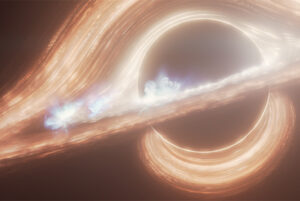JWST reveals ongoing, rapid-fire light show

This artist’s concept portrays the supermassive black hole at the center of the Milky Way galaxy. Several flaring hot spots that resemble solar flares, but on a more energetic scale, are seen in the disk. Image by NASA, ESA, CSA, Ralf Crawford (STScI)
The supermassive black hole at the center of the Milky Way appears to be having a party — and it is weird, wild and wonderful.
Using NASA’s James Webb Space Telescope (JWST), a Northwestern University-led team of astrophysicists has gained the longest, most detailed glimpse yet of the void that lurks in middle of our galaxy.
The swirling disk of gas and dust (or accretion disk) orbiting the central supermassive black hole, called Sagittarius A*, is emitting a constant stream of flares with no periods of rest, the researchers found. While some flares are faint flickers, lasting mere seconds, other flares are blindingly bright eruptions, which spew daily. There also are even fainter flickers that surge for months at a time. The level of activity occurs over a wide range of time — from short interludes to long stretches.
The new findings could help physicists better understand the fundamental nature of black holes, how they interact with their surrounding environments and the dynamics and evolution of our own galactic home.
The study was published today (Feb. 18) in The Astrophysical Journal Letters.
“Flares are expected to happen in essentially all supermassive black holes, but our black hole is unique,” said Northwestern’s Farhad Yusef-Zadeh, who led the study. “It is always bubbling with activity and never seems to reach a steady state. We observed the black hole multiple times throughout 2023 and 2024, and we noticed changes in every observation. We saw something different each time, which is really remarkable. Nothing ever stayed the same.”
An expert on the Milky Way’s center, Yusef-Zadeh is a professor of physics and astronomy at Northwestern’s Weinberg College of Arts and Sciences. The international team of coauthors includes Howard Bushouse of the Space Telescope Science Institute, Richard G. Arendt of NASA, Mark Wardle of Macquarie University in Australia, Joseph Michail of Harvard & Smithsonian and Claire Chandler of the National Radio Astronomy Observatory.
Continue to the full Northwestern news article.

